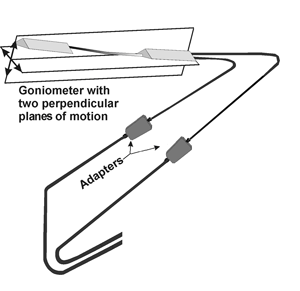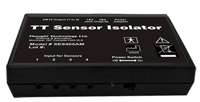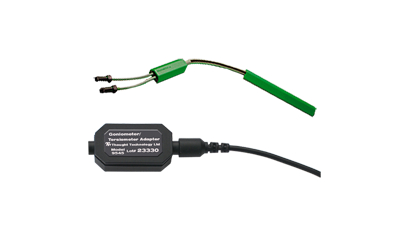GONIOMETER ADAPTER
Model: T9545
- This goniometer adapter connects to Biometrics torsiometers or single and dual axis goniometers, for monitoring joint movement in multiple planes.
- Ideal choice for Ergonomics and Gait Analysis. (Goniometer & Torsiometer to be purchased from Biometrics separately).
Product Overview
 This adapter connects to Biometrics' torsiometers or single and dual axis goniometers, used for monitoring joint movement in multiple planes. Ideal choice for Ergonomics and Gait Analysis.
This adapter connects to Biometrics' torsiometers or single and dual axis goniometers, used for monitoring joint movement in multiple planes. Ideal choice for Ergonomics and Gait Analysis.
(Goniometer & Torsiometer to be purchased from Biometrics Ltd. separately).
A Goniometer or Torsiometer set up comprises two parts, the sensor and the adapter. Two types of Goniometer Adaptor are available; one is labeled Goniometer/Torsiometer Adapter and is for interfacing to the Penny & Giles style sensor, the other is for interfacing with the Flexpoint bend sensor. Both are treated the same with respect to operation. Contact TTL or our authorized dealers for information on purchasing the sensors.
Operating Principle
 A Goniometer/Torsiometer sensor can be sensitive to movement in a number of directions X axis, Y axis and Rotation for a Torsiometer. Goniometers are available in a number of sizes with measurement in up to two axes. Each axis requires a separate adapter. When connected to a person or articulated object they sense changes in angle of one end of the sensor in relation to the other end. The sensor plugs into the adapter.
A Goniometer/Torsiometer sensor can be sensitive to movement in a number of directions X axis, Y axis and Rotation for a Torsiometer. Goniometers are available in a number of sizes with measurement in up to two axes. Each axis requires a separate adapter. When connected to a person or articulated object they sense changes in angle of one end of the sensor in relation to the other end. The sensor plugs into the adapter.
Note: Single Axis Goniometers require one (1) adapter. Twin Axis Goniometers require two (2) adapters.
Technical Specifications
- Size (spprox.) : 370mm x 370mm x 100mm (1.45” x 1.45” x 0.44”)
- Weight (spprox.) : 15g (0.5 oz)
- Input Impedance : > 1MΩ
- Signal Input Range : -180° – +180° (±5° degrees of movement)
- Signal Output Range : 2.200 – 3.400V
- Supply Voltage : 7.26VDC
- Current Consumption : < 4mA @ 7.26 VDC
- Accuracy : ±5%
Interfacing with 3rd Party Data Acquisition Systems
Recommended Connectivity for Electrical Safety
Thought Technology recommends the use of TT Sensor Isolator ST9405AM when interfacing patient connected sensor(s) to line powered equipment(s) or devices.
 The TT Sensor Isolator ST9405AM is an interface device providing medical grade electrical isolation between the patient connected sensors and the acquisition system. It provides the equivalent of Two Means of Patient Protection under IEC 60601-1, and supplies battery power to the sensors. Using this device ensures Thought Technology sensors are safely interfaced to the analog inputs of line-powered systems such as computers with DAQ cards.
The TT Sensor Isolator ST9405AM is an interface device providing medical grade electrical isolation between the patient connected sensors and the acquisition system. It provides the equivalent of Two Means of Patient Protection under IEC 60601-1, and supplies battery power to the sensors. Using this device ensures Thought Technology sensors are safely interfaced to the analog inputs of line-powered systems such as computers with DAQ cards.
Note that this device isolates only between sensors and the DAQ interface, not between different sensor channels.
The TT Sensor Isolator can interface up to 4 sensors to a DAQ card. TT Sensor Isolator can be connected to the DAQ card in two ways:
- via two stereo jacks, or
- via a DB-15 connector; a BNC interface cable (SA9409BNC) or a pigtail cable (SA9409PGT) can be provided with the unit.

For more detailed information on the Sensor Isolator 4∞, consult the Thought Technology Science Division website or contact the sales department or your distributor.
Division website or contact the sales department or your distributor.
Direct Connectivity for Electrically Isolated Systems
The following notes are provided for qualified users to directly interface Thought Technology sensors with external systems.
WARNING: If the sensor is interfaced to non-Thought Technology devices without the use of a TT Sensor Isolator SE9405AM, an elevated risk of electrical shock may be present. In particular, if a patient-connected sensor is connected to any line powered device(s) or equipment(s), it will be the responsibility of the qualified user to ensure the electrical safety in the setup and to ensure that the device or equipment provides sufficient isolation.
To interface with a sensor, a single sensor cable may be cut in half. Both sides can then be used to make custom interfacing cables by stripping the outer insulation of each required conductor. The sensor cable contains 4 color coded conductors. The table below shows the color coding and pin connector assignment.
| Pin | Color Code | Function | Note |
| 1 | metal (shield) | ground | Signal and power ground, connection required. |
| 2 | yellow | auxiliary (sensor ID) | No connection required. |
| 3 | green | signal | Sensor output signal |
| 4 | red | sensor power | Supply voltage, +7.26V referenced to ground. Note: sensor performance may be sensitive to supply voltage. |

Notes:
1. The nominal supply voltage for this sensor is 7.26V. The sensor can safely be used with a supply voltage of up to 9V. However, as the sensor is calibrated with a 7.26V supply voltage level, changes in gain and offset may be expected when operating at a different supply voltage level, changes in gain and offset may be expected when operating at a different supply voltage.
Recommended Specifications for DAQ Hardware
- Recommended resolution of 0.15mV (16-bit ADC over 10V span) or better
- Minimum input range:
- If connected via SE9405AM Sensor Isolator, choose 0-5V (unipolar) or ±5V (bipolar).
- If directly connected to DAQ, choose ±5V (bipolar).
Simplified Transfer Function
![]() Conversion of voltage [V] to BVP%
(for quantitative purposes only)
Conversion of voltage [V] to BVP%
(for quantitative purposes only)
The simplified transfer function assumes the sensor is used with the Sensor Isolator, or the supply voltage provided in the user setup is 7.26V nominal.
Product Overview
 This adapter connects to Biometrics' torsiometers or single and dual axis goniometers, used for monitoring joint movement in multiple planes. Ideal choice for Ergonomics and Gait Analysis.
This adapter connects to Biometrics' torsiometers or single and dual axis goniometers, used for monitoring joint movement in multiple planes. Ideal choice for Ergonomics and Gait Analysis.
(Goniometer & Torsiometer to be purchased from Biometrics Ltd. separately).
A Goniometer or Torsiometer set up comprises two parts, the sensor and the adapter. Two types of Goniometer Adaptor are available; one is labeled Goniometer/Torsiometer Adapter and is for interfacing to the Penny & Giles style sensor, the other is for interfacing with the Flexpoint bend sensor. Both are treated the same with respect to operation. Contact TTL or our authorized dealers for information on purchasing the sensors.
Operating Principle
 A Goniometer/Torsiometer sensor can be sensitive to movement in a number of directions X axis, Y axis and Rotation for a Torsiometer. Goniometers are available in a number of sizes with measurement in up to two axes. Each axis requires a separate adapter. When connected to a person or articulated object they sense changes in angle of one end of the sensor in relation to the other end. The sensor plugs into the adapter.
A Goniometer/Torsiometer sensor can be sensitive to movement in a number of directions X axis, Y axis and Rotation for a Torsiometer. Goniometers are available in a number of sizes with measurement in up to two axes. Each axis requires a separate adapter. When connected to a person or articulated object they sense changes in angle of one end of the sensor in relation to the other end. The sensor plugs into the adapter.
Note: Single Axis Goniometers require one (1) adapter. Twin Axis Goniometers require two (2) adapters.
Technical Specifications
- Size (spprox.) : 370mm x 370mm x 100mm (1.45” x 1.45” x 0.44”)
- Weight (spprox.) : 15g (0.5 oz)
- Input Impedance : > 1MΩ
- Signal Input Range : -180° – +180° (±5° degrees of movement)
- Signal Output Range : 2.200 – 3.400V
- Supply Voltage : 7.26VDC
- Current Consumption : < 4mA @ 7.26 VDC
- Accuracy : ±5%
Interfacing with 3rd Party Data Acquisition Systems
Recommended Connectivity for Electrical Safety
Thought Technology recommends the use of TT Sensor Isolator ST9405AM when interfacing patient connected sensor(s) to line powered equipment(s) or devices.
 The TT Sensor Isolator ST9405AM is an interface device providing medical grade electrical isolation between the patient connected sensors and the acquisition system. It provides the equivalent of Two Means of Patient Protection under IEC 60601-1, and supplies battery power to the sensors. Using this device ensures Thought Technology sensors are safely interfaced to the analog inputs of line-powered systems such as computers with DAQ cards.
The TT Sensor Isolator ST9405AM is an interface device providing medical grade electrical isolation between the patient connected sensors and the acquisition system. It provides the equivalent of Two Means of Patient Protection under IEC 60601-1, and supplies battery power to the sensors. Using this device ensures Thought Technology sensors are safely interfaced to the analog inputs of line-powered systems such as computers with DAQ cards.
Note that this device isolates only between sensors and the DAQ interface, not between different sensor channels.
The TT Sensor Isolator can interface up to 4 sensors to a DAQ card. TT Sensor Isolator can be connected to the DAQ card in two ways:
- via two stereo jacks, or
- via a DB-15 connector; a BNC interface cable (SA9409BNC) or a pigtail cable (SA9409PGT) can be provided with the unit.

For more detailed information on the Sensor Isolator 4∞, consult the Thought Technology Science Division website or contact the sales department or your distributor.
Division website or contact the sales department or your distributor.
Direct Connectivity for Electrically Isolated Systems
The following notes are provided for qualified users to directly interface Thought Technology sensors with external systems.
WARNING: If the sensor is interfaced to non-Thought Technology devices without the use of a TT Sensor Isolator SE9405AM, an elevated risk of electrical shock may be present. In particular, if a patient-connected sensor is connected to any line powered device(s) or equipment(s), it will be the responsibility of the qualified user to ensure the electrical safety in the setup and to ensure that the device or equipment provides sufficient isolation.
To interface with a sensor, a single sensor cable may be cut in half. Both sides can then be used to make custom interfacing cables by stripping the outer insulation of each required conductor. The sensor cable contains 4 color coded conductors. The table below shows the color coding and pin connector assignment.
| Pin | Color Code | Function | Note |
| 1 | metal (shield) | ground | Signal and power ground, connection required. |
| 2 | yellow | auxiliary (sensor ID) | No connection required. |
| 3 | green | signal | Sensor output signal |
| 4 | red | sensor power | Supply voltage, +7.26V referenced to ground. Note: sensor performance may be sensitive to supply voltage. |

Notes:
1. The nominal supply voltage for this sensor is 7.26V. The sensor can safely be used with a supply voltage of up to 9V. However, as the sensor is calibrated with a 7.26V supply voltage level, changes in gain and offset may be expected when operating at a different supply voltage level, changes in gain and offset may be expected when operating at a different supply voltage.
Recommended Specifications for DAQ Hardware
- Recommended resolution of 0.15mV (16-bit ADC over 10V span) or better
- Minimum input range:
- If connected via SE9405AM Sensor Isolator, choose 0-5V (unipolar) or ±5V (bipolar).
- If directly connected to DAQ, choose ±5V (bipolar).
Simplified Transfer Function
![]() Conversion of voltage [V] to BVP%
(for quantitative purposes only)
Conversion of voltage [V] to BVP%
(for quantitative purposes only)
The simplified transfer function assumes the sensor is used with the Sensor Isolator, or the supply voltage provided in the user setup is 7.26V nominal.
Technical Specifications
| Size (spprox.) :370mm x 370mm x 100mm (1.45” x 1.45” x 0.44”) |
| Weight (spprox.) :15g (0.5 oz) |
| Input Impedance : > 1MΩ |
| Signal Input Range :-180° – +180° (±5° degrees of movement) |
| Signal Output Range :2.200 – 3.400V |
| Supply Voltage :7.26VDC |
| Current Consumption : < 4mA @ 7.26 VDC |
| Accuracy : ±5% |
More Products to Consider
Table of Contents
Suggested References

 TT Infra Sensor
TT Infra Sensor